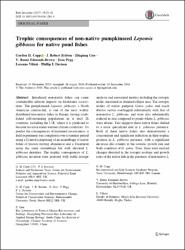Trophic consequences of non-native pumpkinseed Lepomis gibbosus for native pond fishes

View/
Date
2017Author
Copp, Gordon H.Britton, J. Robert
Guo, Zhiqiang
Edmonds-Brown, V. Ronni
Pegg, Josie
Vilizzi, Lorenzo
Davison, Phillip I.
Metadata
Show full item recordAbstract
Introduced non-native fishes can cause considerable adverse impacts on freshwater ecosystems. The pumpkinseed Lepomis gibbosus, a North American centrarchid, is one of the most widely distributed non-native fishes in Europe, having established self-sustaining populations in at least 28 countries, including the U.K. where it is predicted to become invasive under warmer climate conditions. To predict the consequences of increased invasiveness, a field experiment was completed over a summer period using a Control comprising of an assemblage of native fishes of known starting abundance and a Treatment using the same assemblage but with elevated L. gibbosus densities. The trophic consequences of L. gibbosus invasion were assessed with stable isotope analysis and associated metrics including the isotopic niche, measured as standard ellipse area. The isotopic niches of native gudgeon Gobio gobio and roach Rutilus rutilus overlapped substantially with that of non-native L. gibbosus, and were also substantially reduced in size compared to ponds where L. gibbosus were absent. This suggests these native fishes shifted to a more specialized diet in L. gibbosus presence. Both of these native fishes also demonstrated a concomitant and significant reduction in their trophic position in L. gibbosus presence, with a significant decrease also evident in the somatic growth rate and body condition of G. gobio. Thus, there were marked changes detected in the isotopic ecology and growth rates of the native fish in the presence of non-native L. gibbosus. The implications of these results for present and future invaded pond communities are discussed.

















